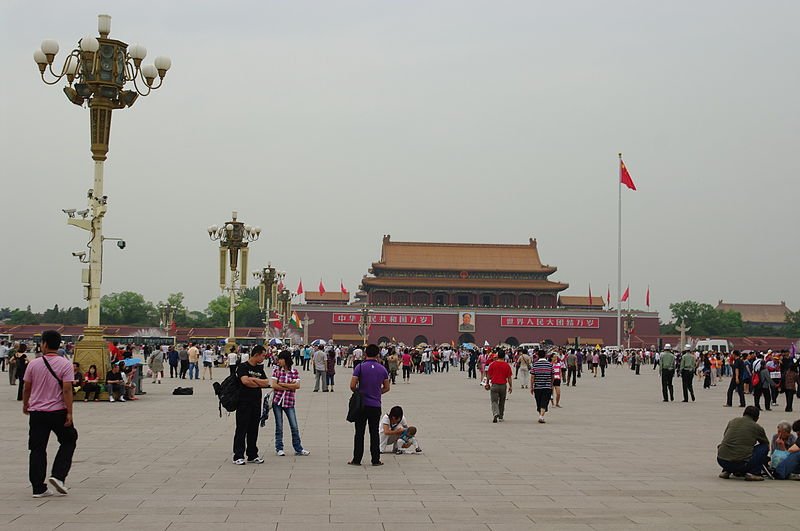 Tiananmen Square, Beijing
Tiananmen Square, BeijingSource: http://commons.wikimedia.org/wiki/File:CN-pek-tiananmen-himml-fried.jpg
Author: Bgabel

Tiananmen Square is a huge square paved in concrete at the heart of Beijing, China. The name Tiananmen means "Gate of the Heavenly Peace".
At the very centre of Tiananmen Square is the Monument to the People's Heroes. Erected in 1958, the granite monument is decorated with carvings that depict China's revolutionary history. It also shows the calligraphy of Chairman Mao and Zhou Enlai.
Mao Tse Tung Mausoleum is the focal point of Tiananmen Square. The mausoleum is flanked by revolutionary statues. Within the mausoleum itself is the embalmed body of the late Chairman Mao. His casket is raised from its refrigerated chamber every morning and afternoon so that the public can see it.
To the north of Tiananmen Square is the entrance to the Forbidden City. This is where you can see the giant portrait of Chairman Mao.
Just across the Chang'an Jie Road from the Forbidden City is the north edge of Tiananmen Square. Here, you can see the flag of China on a huge flagpole, It is raised at dawn and lowered at dusk every day.
To the south of Mao Tse Tung Mausoleum is the Zhengyang Men, or Zhengyang Gate. It was built during the Ming Dynasty. Today it houses a museum recalling the history of Beijing.
Going south again, across Qian Men Dajie Road, is the Arrow Tower, or Jian Lou. It too was built during the Ming Dynasty. Collectively, Zhengyang Men and Arrow Tower are called Qian Men, or Front Gates.
Bordering Tiananmen Square are drab Communist-style buildings which were constructed in the 1950's. On the west side of Tiananmen Square is the Great Hall of the People. This is the seat of the Chinese legislature. It contains an auditorium and banqueting hall. It is open to the public except when the National People's Congress is in session.
On the east side of Tiananmen Square is the China National Museum. It was built in 1959 and was originally the Museum of Chinese History and the Museum of the Revolution. These two museums are now merged as one.
Tiananmen Square is perhaps renowned the world over for the student protest of 1989 which resulted in the massacre of the demonstrators. No trace of that can be seen on Tiananmen Square today. Entrance to the Forbidden City from Tiananmen Square, Beijing
Entrance to the Forbidden City from Tiananmen Square, Beijing
Author: Bgabel

Tiananmen Square is a huge square paved in concrete at the heart of Beijing, China. The name Tiananmen means "Gate of the Heavenly Peace".
At the very centre of Tiananmen Square is the Monument to the People's Heroes. Erected in 1958, the granite monument is decorated with carvings that depict China's revolutionary history. It also shows the calligraphy of Chairman Mao and Zhou Enlai.
Mao Tse Tung Mausoleum is the focal point of Tiananmen Square. The mausoleum is flanked by revolutionary statues. Within the mausoleum itself is the embalmed body of the late Chairman Mao. His casket is raised from its refrigerated chamber every morning and afternoon so that the public can see it.
To the north of Tiananmen Square is the entrance to the Forbidden City. This is where you can see the giant portrait of Chairman Mao.
Just across the Chang'an Jie Road from the Forbidden City is the north edge of Tiananmen Square. Here, you can see the flag of China on a huge flagpole, It is raised at dawn and lowered at dusk every day.
To the south of Mao Tse Tung Mausoleum is the Zhengyang Men, or Zhengyang Gate. It was built during the Ming Dynasty. Today it houses a museum recalling the history of Beijing.
Going south again, across Qian Men Dajie Road, is the Arrow Tower, or Jian Lou. It too was built during the Ming Dynasty. Collectively, Zhengyang Men and Arrow Tower are called Qian Men, or Front Gates.
Bordering Tiananmen Square are drab Communist-style buildings which were constructed in the 1950's. On the west side of Tiananmen Square is the Great Hall of the People. This is the seat of the Chinese legislature. It contains an auditorium and banqueting hall. It is open to the public except when the National People's Congress is in session.
On the east side of Tiananmen Square is the China National Museum. It was built in 1959 and was originally the Museum of Chinese History and the Museum of the Revolution. These two museums are now merged as one.
Tiananmen Square is perhaps renowned the world over for the student protest of 1989 which resulted in the massacre of the demonstrators. No trace of that can be seen on Tiananmen Square today.
Photos of Tiananmen Square
 Entrance to the Forbidden City from Tiananmen Square, Beijing
Entrance to the Forbidden City from Tiananmen Square, BeijingSource: http://commons.wikimedia.org/wiki/File:Commuting_to_Work.jpg
Author: Peter Morgan

 Monument in front of Mao Mausoleum, Beijing
Monument in front of Mao Mausoleum, Beijing
Author: Peter Morgan

 Monument in front of Mao Mausoleum, Beijing
Monument in front of Mao Mausoleum, BeijingSource: http://commons.wikimedia.org/wiki/File:Tianamen_Square-Monument.jpg
Author: Saad Akhtar

Looking for information on Penang? Use this Map of Roads in Penang to zoom in on information about Penang, brought to you road by road.

Author: Saad Akhtar

 Latest updates on Penang Travel Tips
Latest updates on Penang Travel Tips
 Map of Roads in Penang
Map of Roads in Penang
Looking for information on Penang? Use this Map of Roads in Penang to zoom in on information about Penang, brought to you road by road.
Copyright © 2003-2025 Timothy Tye. All Rights Reserved.

 Go Back
Go Back